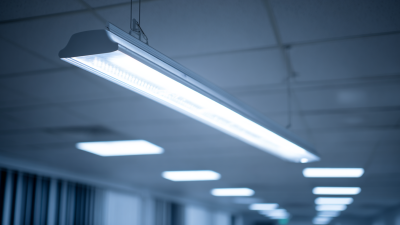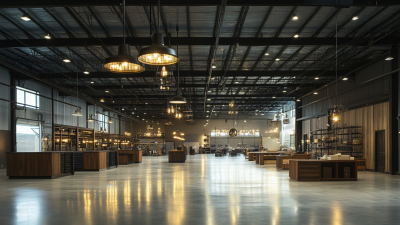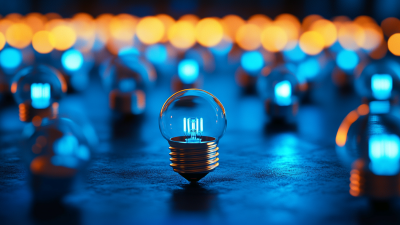Mastering LED Lighting Techniques for Energy Efficiency in Your Home
In recent years, the demand for energy-efficient home lighting solutions has surged, with studies indicating that LED lighting can reduce energy consumption by up to 80% compared to traditional incandescent bulbs. As homeowners increasingly seek to lower their energy bills and minimize their environmental footprint, mastering LED lighting techniques has become essential. According to the U.S. Department of Energy, widespread adoption of LED lighting could save the nation approximately $30 billion annually in energy costs.

This blog will explore top strategies for effectively utilizing LED lighting in your home, highlighting practical applications that not only enhance aesthetics but also contribute significantly to energy efficiency and sustainability. Embracing these techniques will empower you to create a well-lit environment while reaping the financial and ecological benefits of modern lighting technology.
Understanding LED Basics: How LED Technology Works for Your Home
Understanding how LED technology works is essential for enhancing energy efficiency in your home. At its core, LED (Light Emitting Diode) technology operates on the principle of electroluminescence, where electricity passes through a semi-conductive material to produce light. This process is not only energy-efficient but also generates significantly less heat compared to traditional lighting methods. By choosing LEDs, homeowners can drastically reduce their energy consumption while maintaining excellent light quality.
Moreover, advancements such as Direct View LED (DVLED) have emerged, further transforming how we utilize LED technology. DVLED systems enable a direct display of vivid images and texts, creating immersive experiences without the bulk of conventional displays. The advantages of DVLED include enhanced brightness, superior contrast, and lower energy consumption, making it an ideal choice for both home and commercial environments. By understanding these fundamental principles and innovations in LED technology, homeowners can make informed decisions that maximize energy savings and improve their overall living spaces.
The Benefits of LED Lighting for Energy Efficiency and Cost Savings
LED lighting has emerged as a leader in energy-efficient solutions for residential spaces, offering significant cost savings compared to traditional lighting options. According to the U.S. Department of Energy, LED lights use at least 75% less energy than incandescent bulbs and can last up to 25 times longer. This remarkable longevity not only reduces the frequency of replacements but also diminishes waste, contributing to a more sustainable environment.
The financial benefits of switching to LED lighting are equally compelling. The Energy Saving Trust estimates that households can save approximately £40 a year by replacing just five traditional bulbs with LEDs. This translates into substantial long-term savings, as the initial investment in LED technology is quickly offset by reduced electricity bills. Additionally, lower energy consumption can lead to less strain on power plants, resulting in decreased greenhouse gas emissions—further solidifying LEDs as a significant player in both individual cost savings and broader environmental benefits.
Choosing the Right LED Bulbs: A Guide to Brightness, Color Temperature, and Usage
When choosing the right LED bulbs for your home, brightness and color temperature play crucial roles in creating the perfect ambiance. LED bulbs come in varying lumens, which measure brightness. For general lighting, opt for bulbs that produce at least 800 lumens, suitable for living rooms or kitchens. If you seek a cozy atmosphere, a lower-lumen bulb can work wonders, especially in bedrooms or reading nooks.
Color temperature is another key factor to consider. Measured in Kelvin (K), this determines the warmth or coolness of the light. For a warm, inviting feel, choose bulbs with a lower Kelvin rating (2700K-3000K). For tasks that require better visibility, such as in home offices or garages, aim for higher Kelvin ratings (4000K-5000K) to mimic daylight.
Tip: Always check the packaging for both brightness and color temperature. Don't overlook the energy efficiency ratings; look for bulbs with the ENERGY STAR label to ensure optimal performance while reducing energy costs.
Tip: Experiment with different bulbs in your space to find the perfect combination of brightness and color temperature that suits your needs best. This trial-and-error method can lead to significant improvements in your home’s lighting both practically and aesthetically.
Advanced LED Techniques: Dimming, Smart Controls, and Customization Options
LED lighting has transformed how we approach energy efficiency in our homes. With advanced techniques such as dimming, smart controls, and customization options, homeowners can now optimize their lighting for both functionality and aesthetic appeal.
Dimming is one of the simplest yet most effective methods to enhance energy efficiency. By reducing the brightness when full illumination is unnecessary, you can significantly cut down on energy consumption while creating the perfect ambiance for any occasion.
Incorporating smart controls into your LED setup adds another layer of efficiency and convenience. Smart bulbs can be programmed to adjust based on time of day or occupancy, ensuring that your lights are only on when needed. For instance, consider using motion sensors in less-frequented areas like bathrooms or hallways to automatically turn lights on and off, saving energy without any extra effort.
Customization options also play a vital role in maximizing the benefits of LED lighting. Choose color temperature settings that suit different rooms—warm white for a cozy living room and brighter daylight for a productive workspace. Additionally, utilizing smart apps to control your lighting preferences from your smartphone can streamline your home’s energy use while maintaining a personalized touch to your space.
Creating an Energy-Efficient Lighting Plan: Room-by-Room Strategies for Your Home
Creating an energy-efficient lighting plan for your home requires a thoughtful, room-by-room strategy that maximizes both illumination and energy savings. According to the U.S. Department of Energy, replacing incandescent bulbs with LED lighting can save up to 75% on electricity costs, translating to significant savings over time. In living areas and bedrooms, utilizing dimmable LEDs allows for customization of brightness based on activities, further enhancing energy efficiency while creating a cozy atmosphere.
Kitchens and workspaces benefit from task lighting that focuses on key areas, reducing the need for overhead lights. By choosing LED fixtures with a higher lumen output in these spaces, homeowners can ensure adequate lighting while keeping energy consumption low. A report by the Lighting Research Center highlights that strategically placing lights to minimize dark spots reduces reliance on more powerful, energy-hungry fixtures.
Overall, evaluating each room's specific lighting needs, selecting the right LED solutions, and implementing smart controls can lead to a significant reduction in energy use across the home.
Related Posts
-

How to Choose the Best LED Lighting for Your Home or Office Needs
-

Ultimate Guide to Selecting the Best LED Lighting Solutions for Global Buyers
-

Exploring the Advantages of Led Lighting in Energy Efficiency and Cost Savings for Modern Businesses
-

Ultimate Guide to Choosing the Best Lighting Fixtures for Your Business Needs
-

7 Essential Tips to Boost Energy Efficiency with LED Lighting
-

The Ultimate Guide to Finding the Best Quality Lighting Solutions for Global Buyers

